In my somewhat new Monday slot, more of my posts fall on holidays (duh!) and I have just let them pass. Last month, for example, Valentine’s Day came and went, but my heart wasn't in it. Today, however, I’d like to celebrate this week’s unofficial holiday that, in my opinion, deserves to become official--the onset of Daylight Saving Time (DST). What an emotionally lifting gift—especially to New Englanders who have been battling the suicidal impulses that accompany a 4:30 sunset. For months we have tried to keep our spirits up as the light inched back a minute at a time. Then PRESTO CHANGO! In just one day, arbitrary magic multiplies the jump times 60. We get a whole new hour of light—and life becomes brighter in every way. If only Zoloft worked so well.
Today, however, I’d like to celebrate this week’s unofficial holiday that, in my opinion, deserves to become official--the onset of Daylight Saving Time (DST). What an emotionally lifting gift—especially to New Englanders who have been battling the suicidal impulses that accompany a 4:30 sunset. For months we have tried to keep our spirits up as the light inched back a minute at a time. Then PRESTO CHANGO! In just one day, arbitrary magic multiplies the jump times 60. We get a whole new hour of light—and life becomes brighter in every way. If only Zoloft worked so well.
As nonfiction writers we are obligated to tell the truth and nothing but the truth, right? What about the whole truth, though? In this case, I would have to admit that DST causes increased danger of traffic and pedestrian accidents during its first week because of sleep cycle disruption. It was never created to help the farmers or reinstated more recently to save energy. In fact, farmers hate it and many experts believe it increases energy costs: electricity for air conditioning and over $100 million a year for the airlines.
 Why did this idea gain purchase? Some British golfer in 1907 realized that if one hour of sunlight was switched from the sunrise side to sunset, he’d have time to get to the back nine. In fact, when the 1986 Congress debated the issue of extending it into March, the golf lobby went to town. According to Michael Downing, author of Spring Forward: The Annual Madness of Daylight Saving Time, the golf industry estimated the extension of DST would increase their revenues by 400 million 1986 dollars, the barbecue industry over $100 million. In other words, if you give Americans the chance to go outside at any time, they will spend money.
Why did this idea gain purchase? Some British golfer in 1907 realized that if one hour of sunlight was switched from the sunrise side to sunset, he’d have time to get to the back nine. In fact, when the 1986 Congress debated the issue of extending it into March, the golf lobby went to town. According to Michael Downing, author of Spring Forward: The Annual Madness of Daylight Saving Time, the golf industry estimated the extension of DST would increase their revenues by 400 million 1986 dollars, the barbecue industry over $100 million. In other words, if you give Americans the chance to go outside at any time, they will spend money.
Telling the whole truth about DST is not a horror. An ironic example of one of America’s worst traits, perhaps, but not a deal-killer. In the unlikely event that I ever wrote a book about DST, I’d “out” its origins with relish.
But what about other times, when telling the whole truth in our books for younger children is a lot more painful? Then how far do we go? I just attended a conference on sustainable energy this week where everyone had already accepted the devastating long range consequences of climate change as inevitable. Nobody was talking about getting better gas mileage or "clean coal." The focus was on how to think about reconfiguring communities in the Brave New World. I'm not considering a book about this subject either; but how do you give kids hope and this kind of information at the same time?  When I wrote See How They Run: Campaign Dreams, Election Schemes, and the Race to the White Hous
When I wrote See How They Run: Campaign Dreams, Election Schemes, and the Race to the White Hous
Viewing: Blog Posts Tagged with: 2008 titles, Most Recent at Top [Help]
Results 1 - 13 of 13
Blog: I.N.K.: Interesting Non fiction for Kids (Login to Add to MyJacketFlap)
JacketFlap tags: nonfiction, writing, American Revolution, 2008 titles, Susan E. Goodman, US History, Deborah Heiligman, finding the truth, climate science, Add a tag
Blog: I.N.K.: Interesting Non fiction for Kids (Login to Add to MyJacketFlap)
JacketFlap tags: book reviews, 2008 titles, Kathleen Krull, 2009 titles, Add a tag
 Trust Kathryn Lasky to be first up with what may end as one of the year’s best— One Beetle Too Many: The Extraordinary Adventures of Charles Darwin. It’s a sumptuous party for He-Who-Must-Not-Be-Named in certain swaths of the population. The title (which, with a vowel change, could have been One Beatle Too Many: The Story of Pete Best) refers to the famous incident in which young Charles found himself with three rare beetles and only two hands. Showing his dedication early on, he popped one bug in his mouth until he could get to his collecting bottle. The text goes on to shape Darwin into a flesh-and-blood being, and explains the “evolution” of his theories in ways that go down easily. Despite an abrupt ending (without even an author's note to provide more context), this scores points for addressing head-on how evolution fit in with Darwin’s religious beliefs, what creationism is, and the controversy hinted at by Lasky’s dedication: “In celebration of children, whose boundless curiosity gives them a right to know their history on Earth.” Matthew Trueman’s illustrations in mixed-media (the media including weeds and wildflowers) are to drool over (Candlewick, ages 9-12).
Trust Kathryn Lasky to be first up with what may end as one of the year’s best— One Beetle Too Many: The Extraordinary Adventures of Charles Darwin. It’s a sumptuous party for He-Who-Must-Not-Be-Named in certain swaths of the population. The title (which, with a vowel change, could have been One Beatle Too Many: The Story of Pete Best) refers to the famous incident in which young Charles found himself with three rare beetles and only two hands. Showing his dedication early on, he popped one bug in his mouth until he could get to his collecting bottle. The text goes on to shape Darwin into a flesh-and-blood being, and explains the “evolution” of his theories in ways that go down easily. Despite an abrupt ending (without even an author's note to provide more context), this scores points for addressing head-on how evolution fit in with Darwin’s religious beliefs, what creationism is, and the controversy hinted at by Lasky’s dedication: “In celebration of children, whose boundless curiosity gives them a right to know their history on Earth.” Matthew Trueman’s illustrations in mixed-media (the media including weeds and wildflowers) are to drool over (Candlewick, ages 9-12). Among the millions and billions of Lincoln titles (of which I will have one, Abraham Lincoln Tells a Joke, in 2010), one of the most un-put-down-able is Chasing Lincoln's Killer. James L. Swanson has taken his adult bestseller Manhunt: The 12-Day Chase for Lincoln's Killer and refashioned it with verve for young adults. “Chase” is the operative word—this search for John Wilkes Booth and his conspirators moves at a rip-snorting clip, aided by lots of just-what-you'd-want-to-know details and an energetic design in sepia printed on creamy stock (Scholastic, ages 12 and up).
Among the millions and billions of Lincoln titles (of which I will have one, Abraham Lincoln Tells a Joke, in 2010), one of the most un-put-down-able is Chasing Lincoln's Killer. James L. Swanson has taken his adult bestseller Manhunt: The 12-Day Chase for Lincoln's Killer and refashioned it with verve for young adults. “Chase” is the operative word—this search for John Wilkes Booth and his conspirators moves at a rip-snorting clip, aided by lots of just-what-you'd-want-to-know details and an energetic design in sepia printed on creamy stock (Scholastic, ages 12 and up). A big “wow” goes to How Weird Is It? A Freaky Book All About Strangeness by Ben Hillman. With alluring chapters like “Fungus Is Family” and photos cleverly Photo-shopped for maximum drama, this looks like a tabloid-y item you might hand to the most reluctant of reluctant readers. Surprise—it’s a science book. A real one, with unsourced but fascinating information about neutron stars, the Big Bang, dark energy, plagues, ghost particles, bizarre animals, what Martians might look us (us), all the latest hot topics in science. For any reader, reluctant or otherwise (Scholastic, ages 8-12).
A big “wow” goes to How Weird Is It? A Freaky Book All About Strangeness by Ben Hillman. With alluring chapters like “Fungus Is Family” and photos cleverly Photo-shopped for maximum drama, this looks like a tabloid-y item you might hand to the most reluctant of reluctant readers. Surprise—it’s a science book. A real one, with unsourced but fascinating information about neutron stars, the Big Bang, dark energy, plagues, ghost particles, bizarre animals, what Martians might look us (us), all the latest hot topics in science. For any reader, reluctant or otherwise (Scholastic, ages 8-12).
Finally, we say farewell to 2008 titles (while wondering if the ALA committees will reward any of them come January 26). My apologies to the ones I didn’t get to, like Brenda Z. Guiberson's purely poetic Ice Bears… the dreamy All About Sleep From A to Zzzz by Elaine Scott (drawings by John O'Brien!!)… the truly niche-filling Sing My Song: A Kid's Guide to Songwriting by Steve Seskin... Sandra Markle's innovative Animals Christopher Columbus Saw: An Adventure in the New World…. what else did I miss???
Blog: I.N.K.: Interesting Non fiction for Kids (Login to Add to MyJacketFlap)
JacketFlap tags: lists, 2008 titles, Loreen Leedy, writing for kids, Add a tag
 My fall book tells a tale using only similes as the text. The easiest way to get a sense of it is to watch this video preview. The impetus to create Crazy Like Fox: A Simile Story was to follow up on a previous book of sayings (There’s a Frog in My Throat) while using a different format. Frog is a compendium of over 400 sayings; Crazy tells a story as well as having several similes on each page. Every time a character is compared to something, he or she turns into it. For example, when Rufus is sleeping like a log, on the next page he becomes a log (and even snores like a chain saw.) This enabled me to have tons of fun with the illustrations. It’s been well-received, with a starred review from Kirkus.
My fall book tells a tale using only similes as the text. The easiest way to get a sense of it is to watch this video preview. The impetus to create Crazy Like Fox: A Simile Story was to follow up on a previous book of sayings (There’s a Frog in My Throat) while using a different format. Frog is a compendium of over 400 sayings; Crazy tells a story as well as having several similes on each page. Every time a character is compared to something, he or she turns into it. For example, when Rufus is sleeping like a log, on the next page he becomes a log (and even snores like a chain saw.) This enabled me to have tons of fun with the illustrations. It’s been well-received, with a starred review from Kirkus.
I’m not aware of any similar book where the text consists of only similes, but please let me know if there is one for curiosity’s sake. The title was the first simile chosen, and the plot needed to explain what “crazy like a fox” means. So, Rufus the fox had to act weird for some reason that would make sense by the end of the story. In the manuscript’s early stages, he was jumping as high as a kite to get over a fence, running as fast as the wind to escape some critter, and finally building a contraption to vault him across a river to get breakfast at Mama Somebody's Cafe. The ending seemed a tad flat, though.
Meanwhile, I was busy collecting similes. If there’s some master web site full of zillions of ‘em, I never found it. This one has a fair number (you have to scroll down a bit.) But mostly, I had to compile a list using various general idiom or cliché sites. One of my favorites is this one that you can search by key word. Of course, only a small percentage of any group of sayings are similes, so it took awhile to get a reasonable number to “audition” as part of a potential text. After amassing quite a few, for the sake of organization they had to be put in alphabetical order by first key word. Thus, as tall as a giraffe came before as tough as nails. For Frog I had made a database, but for this project a list worked fine. I did separate “like” from “as“ similes to make it easier and to ensure there was a good balance of both forms in the book. Also, I left out similes that were obviously unsuitable because they were too antiquated (as mad as a hatter), inappropriate for young children (like a bat out of hell), or probably wouldn’t fit into the story. Whatever the story turned out to be, that is.
Eventually the idea popped into my head for Rufus to pick on his friend Babette the sheep, and thus lure her into chasing him all the way to her own surprise birthday party. The party is as noisy as a herd of elephants, so of course the guests turn into... elephants! If you’ve never seen a possum, a crow, a ladybug and several other critters transformed into long-trunked proboscideans, this is your chance.
In the book biz, snags can crop up anywhere, and towards the end there was suddenly a title problem. Namely, the publisher wanted me to jettison the title Crazy Like a Fox and call it Simply Similes. Rather than freaking out (my first impulse,) I sent them a list of the pros of keeping the title as it was, plus the requirements for any alternate title (has to be catchy and fun, inspire kids to read it, tie in with the story, and so on.) I also had the chance to mention the issue to a group of teachers who all were in favor of the original title, and POOF! that little issue went away (yay!)
Blog: I.N.K.: Interesting Non fiction for Kids (Login to Add to MyJacketFlap)
JacketFlap tags: 2008 titles, Don Brown, Add a tag
My newest titles were published this Fall.
All Stations! Distress! about the Titanic and Let It Begin Here! about the Battle of Lexington and Concord are departures from my usual biographical-picture-books-for-younger-readers fare. Instead, they are longer format books aimed squarely at nine to twelve-year-old readers.
Whereas my picture books are studies in “reduction” – What can I leave out without damaging the narrative arc of the story or, worse, skewing historical accuracy – The longer text in the new books allowed me to explore details of the story as well as employ more complex sentences. (Even so, I’m still a sucker for the straight-forward declarative sentence.) And I could indulge in art more appropriate for an older audience, specifically of the ‘blood and guts’ variety.
All Stations! Distress! received starred reviews from the Horn Book and School Library Journal. SLJ also awarded Let It Begin Here! a starred review.

Blog: I.N.K.: Interesting Non fiction for Kids (Login to Add to MyJacketFlap)
JacketFlap tags: 2008 titles, Loreen Leedy, writing for kids, writing non-fiction, Add a tag
Continued from last month. The first half of this post is here.
Occasionally a notion comes from my own personal reading. If it’s interesting enough for adults to read about, maybe a version for kids could work, too. In general over the years, there has been a move towards introducing many subjects to ever-younger readers. On the other hand, sometimes there’s a good reason a topic hasn’t been done as a picture book because too many complex concepts are involved, it’s not visual enough, it’s too difficult emotionally, and so on. (Some picture book authors do indeed tackle some very tough themes, with varying success.) I try to imagine my 2nd grade self... would I have wanted to hear about this?
Kids provide great clues, too. In addition to observing my young relatives in their natural habitat, I’ve taken quite a few photos of student-made projects hanging on school walls that show what they find interesting and/or funny. Unicorns? Muscle men? Futuristic cars? Lemurs? Kings and queens? There often is a regional flavor... surfers may appear at the coast while young camo-clad hunters roam in rural areas.
I usually have a few potential book ideas brewing at all times, and a fun way to see what has been published recently is to attend ALA, IRA, and other book conferences. Nothing beats browsing through the pages. Wandering from booth to booth, I check out what IS or is NOT being done with my possible book topics. And if a book or two exist already, are they well-designed, entertaining, satisfying? Do they take a similar or a very different approach than what I’m thinking?
Several of my books have been follow-ups to previous books. Not necessarily sequels, they may be more loosely related. Most recently I wanted to do another sayings book like There’s a Frog in My Throat, but didn't want to duplicate the format of 48 pages filled with over four hundred sayings (which took eons to illustrate!) Instead, I focused just one type, creating a surprising tale exclusively with similes in my Fall 2008 book, Crazy Like a Fox: A Simile Story. To get an inside peek, check out this fun musical video trailer. By the way, one of my editors passed along a trend spotted in a college-level early education class: using book trailers as a “reader motivation technique.“ Sounds like an excellent idea to me!
I often do get vague book ideas in the random pop-into-the-head way, but then need to develop them further via brainstorming. A book that I learned several brainstorming techniques from is an oldie but goody, Wishcraft, by Barbara Sher. It’s great for opening up new possibilities, breaking out of a dry period, or organizing a tangle of competing goals. When I first read it shortly after finishing college, it definitely expanded my vision of what I could do with my life. It’s now available for free online here.
One thing I don’t worry too much about is the competition from textbook companies. Just because they have published a topic doesn't mean there isn't room for a fun, creative book from me (or you). If anything, the fact that a textbook company has included a subject probably means there’s a definite interest in it. They all have web sites with an online catalog. For example, on the National Geographic school publishing site, you can search by grade level and subject.
I’m sure other I.N.K. authors have their own favorite ways to find good topics, if anybody cares to chime in! It’s always fun the hear the origin story behind an author’s book.
Blog: I.N.K.: Interesting Non fiction for Kids (Login to Add to MyJacketFlap)
JacketFlap tags: biography, 2008 titles, Kathleen Krull, Add a tag
 We don’t get to talk about him much on this blog—his Honorary Wackiness, National Ambassador for Children’s Literature, Silly-Silly Fiction Writer: Jon Scieszka. But now, by way of explaining where he gets his book ideas, he has written his autobiography— Knucklehead: Tall Tales and Almost True Stories of Growing up Scieszka—and that makes him eligible for some I.N.K. loving. Six brothers, Catholic school, the 1960s, a genius sense of humor—some great material here for a future writing career. The text, speckled with photos and scrapbook items, is broken into 38 little essays. Many of them sparkle with the polished wit of a Dave Barry or David Sedaris—especially those essays with nuns, like “I Swear” and “What’s So Funny, Mr. Scieszka?” In the latter piece, young Jon makes the momentous choice to incur the wrath of Sister Margaret Mary by entertaining the rest of the class with a joke—and the rest is history. Aimed squarely at reluctant boy readers (Viking, ages 9-11).
We don’t get to talk about him much on this blog—his Honorary Wackiness, National Ambassador for Children’s Literature, Silly-Silly Fiction Writer: Jon Scieszka. But now, by way of explaining where he gets his book ideas, he has written his autobiography— Knucklehead: Tall Tales and Almost True Stories of Growing up Scieszka—and that makes him eligible for some I.N.K. loving. Six brothers, Catholic school, the 1960s, a genius sense of humor—some great material here for a future writing career. The text, speckled with photos and scrapbook items, is broken into 38 little essays. Many of them sparkle with the polished wit of a Dave Barry or David Sedaris—especially those essays with nuns, like “I Swear” and “What’s So Funny, Mr. Scieszka?” In the latter piece, young Jon makes the momentous choice to incur the wrath of Sister Margaret Mary by entertaining the rest of the class with a joke—and the rest is history. Aimed squarely at reluctant boy readers (Viking, ages 9-11). Anyone who saw him play piano at the Beijing Olympics opening ceremony will be fascinated by Lang Lang: Playing with Flying Keys, an autobiography written with Michael French. Search for “Lang Lang” on YouTube, and be intoxicated by this Chinese master of Western classical piano music. No superlative is too super to describe his showy technique and pure emotion—think Chopin, Liszt, Beethoven-- and he’s still only 26. His life is a harrowing mythical journey from being a child without a childhood—a prodigy in a poor family, with a loving if strict-unto-abusive father-- all the way to rock-star-like fame and fortune. Along the way, readers will absorb a considerable amount about China, its history and culture, as well as the power of all kinds of music, particularly classical. A recent New Yorker reports that 40 million children in China are currently studying piano—the “Lang Lang effect” that could easily migrate here (Delacorte, ages 9 and up).
Anyone who saw him play piano at the Beijing Olympics opening ceremony will be fascinated by Lang Lang: Playing with Flying Keys, an autobiography written with Michael French. Search for “Lang Lang” on YouTube, and be intoxicated by this Chinese master of Western classical piano music. No superlative is too super to describe his showy technique and pure emotion—think Chopin, Liszt, Beethoven-- and he’s still only 26. His life is a harrowing mythical journey from being a child without a childhood—a prodigy in a poor family, with a loving if strict-unto-abusive father-- all the way to rock-star-like fame and fortune. Along the way, readers will absorb a considerable amount about China, its history and culture, as well as the power of all kinds of music, particularly classical. A recent New Yorker reports that 40 million children in China are currently studying piano—the “Lang Lang effect” that could easily migrate here (Delacorte, ages 9 and up). For a jewel of a picture-book biography, dive into the sea with Manfish: A Story of Jacques Cousteau. The famous French oceanographer started out as a little boy pulsating with curiosity—about the qualities of water, the mysterious creatures below, whether a human could ever learn to breathe underwater, how a camera worked, how to make movies. Above all, how could he become a manfish—“to swim through the sea as free as a fish.” The story of how he does just that, creating beautiful films that inspire others to take care of the oceans, is told with poetic economy by Jennifer Berne (in her first book for children!). French artist Éric Puybaret paints wondrous, fluid images to match (Chronicle, ages 4-7).
For a jewel of a picture-book biography, dive into the sea with Manfish: A Story of Jacques Cousteau. The famous French oceanographer started out as a little boy pulsating with curiosity—about the qualities of water, the mysterious creatures below, whether a human could ever learn to breathe underwater, how a camera worked, how to make movies. Above all, how could he become a manfish—“to swim through the sea as free as a fish.” The story of how he does just that, creating beautiful films that inspire others to take care of the oceans, is told with poetic economy by Jennifer Berne (in her first book for children!). French artist Éric Puybaret paints wondrous, fluid images to match (Chronicle, ages 4-7). Wiser minds than mine might have predicted this, but while Fartiste came flying through with some great reviews, my Hillary Rodham Clinton: Dreams Taking Flight is taking a beating. Possible reasons? Lots of free-floating Hillary hysteria going around; the book came out as the same time as books on Obama and McCain, which makes cynics suspect we authors are in some way cashing in; and perhaps it’s possible that I wrote a bad book. Fortunately, Richie Partington likes it. I’m still in awe of Amy June Bates’ uncannily accurate depictions of Hillary in all the stages of her life. And I stand by my statement that the book was written in all sincerity (Simon & Schuster, ages 5-10).
Wiser minds than mine might have predicted this, but while Fartiste came flying through with some great reviews, my Hillary Rodham Clinton: Dreams Taking Flight is taking a beating. Possible reasons? Lots of free-floating Hillary hysteria going around; the book came out as the same time as books on Obama and McCain, which makes cynics suspect we authors are in some way cashing in; and perhaps it’s possible that I wrote a bad book. Fortunately, Richie Partington likes it. I’m still in awe of Amy June Bates’ uncannily accurate depictions of Hillary in all the stages of her life. And I stand by my statement that the book was written in all sincerity (Simon & Schuster, ages 5-10).
Blog: I.N.K.: Interesting Non fiction for Kids (Login to Add to MyJacketFlap)
JacketFlap tags: 2008 titles, Writing Nonfiction, Loreen Leedy, writing non-fiction, Add a tag
In my early years as a picture book author-illustrator, I read some how-to books to learn more about the field. One had a statement to the effect that “there isn’t anything NEW you can do in children’s books, but try to think of a fresh angle” on the same old thing, presumably. It may be that whoever concocted that theory was thinking about fiction... there have been quite a few books about “the seven basic plots,” or whatever number an author comes up with. And heaven knows, the world surely doesn’t need another variation on the endless I'll Love You Till the Cows Come Home or the Sun Explodes, Whichever Comes First genre of picture book(!)
When it comes to nonfiction though, there are plenty of subjects that haven't been adapted for the picture book age. My first school visits inspired an idea...it became clear that writing was emphasized at an earlier age in the curriculum than during my elementary years, even in Kindergarten. The thought occurred to me that if these young students had writing skills, what could they do with them? How about making a newspaper? I checked in Children’s Books in Print, and there weren't any books for kids about it, except perhaps a documentary-style book about being a journalist. I wanted to show characters working together to create their own newspaper. That question, “what can kids write?” resulted in The Furry News: How to Make a Newspaper, then later books about writing letters and books.
I routinely research the competition (if any) to see if a subject has been done to death or not. Rather than a drive to the library to rummage through Books in Print, nowadays a search on Amazon quickly shows what has been published. (The Advanced Search limits titles to the 4-8 year range for picture books.) It’s not uncommon to find a topic that has only one or even zero picture books about it, which makes me more inclined to pursue it. Also, and this may be obvious, but Amazon or any search engine is the best way to test titles. For example, once I was considering When Pigs Fly as a title, but there were already several published books entitled with that phrase. No sense in confusing potential readers.
So how do authors find a neglected topic to write a book about? The classic method is to have an idea pop into your head seemingly out of nowhere. But if that fails, read on...
Often teachers, librarians, parents, and other book people can suggest ideas. “You should write a book about X.” These are often excellent leads, although despite several suggestions I have yet to attempt a book about Groundhog Day. When I send out my enewsletter, I always ask for ideas and usually get some good ones. Editors are another great source, naturally. My longtime editor (Margery Cuyler) once told me there weren’t many picture books about math and how about giving one a try? Which has turned into eleven books so far. Not every externally-generated suggestion will fit, which is the way it goes. But sometimes a not-so-good idea can spark a thought process that leads to a great one.
Checking out curriculum guides and/or standards can be intriguing, such as those developed by the National Council of Teachers of Mathematics. These can often be viewed or downloaded from the web sites of national associations, local school districts, or from a state level organization, such as this one for Florida. I don't know about you, but to me this practically pulsates with possibilities: Differentiate between living and non-living things.
(To be continued next month.)
Blog: I.N.K.: Interesting Non fiction for Kids (Login to Add to MyJacketFlap)
JacketFlap tags: book reviews, 2008 titles, Kathleen Krull, Add a tag
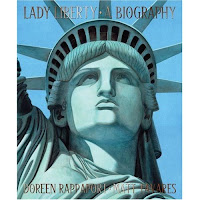 ...and more or less in tune with 4th of July partying.
...and more or less in tune with 4th of July partying.Pickers of nits may have a tricky time classifying the gorgeous new picture book about our emblem of freedom-- Lady Liberty: A Biography. What is noted author Doreen Rappaport doing with these free-verse poems, in the various voices of all who had a hand in creating the Statue of Liberty? The first poem is autobiographical, describing her Latvian grandfather seeing the statue for the first time. Then, from French sculptor Auguste Bartholdi to others famous and not so famous, the voices tell a true story-- how the statue was conceived and built and what it’s meant to immigrants ever since. Here is the voice of poet Emma Lazarus: “Soon when people arrive in the New World,/they will be welcomed/by a caring, powerful woman,” Rappaport writes, segueing into Lazarus’s own invocation: “Give me your tired, your poor,/Your huddled masses yearning to breathe free…” Besides being inspirational, the poems are obviously the fruit of mountains of research, and meanwhile Rappaport has collected every possible fact you could want to know into the back matter. Somber paintings by Matt Tavares swoop from unusual angles to heighten the drama. The format is large and inviting, with a “ta-da” fold-up page unveiling the completed Lady in all her magnificence. This is history, biography, and a tribute evoking genuine emotion-- all at the same time. I would call it seriously creative nonfiction (Candlewick, ages 5-8).
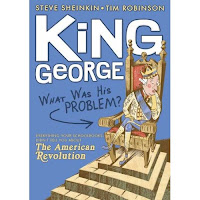 For older readers, the title alone-- King George: What Was His Problem?—may result in kids grabbing this book. The additional line of “Everything Your Schoolbooks Didn't Tell You About the American Revolution”—sounds mighty cool. Steve Sheinkin, the author of textbooks even he thinks of as tedious, has here amassed all the good stuff he claims his prim textbook editors wouldn’t allow him to use. That makes us the beneficiary of a clear, witty, fast-paced account that reads like a novel, even to the point of including some surprisingly clever dialog. Ben Franklin and grumpy John Adams, forced to share a bed one night, argue over whether the window should be open or closed. “I believe you are not acquainted with my theory of colds,” begins Franklin, lulling angry Adams into submission: “I was so much amused that I soon fell asleep.” Often one battle after another, this account might be more blow-by-blow than some kids will persist with (actually, this works well as a primer for adults). But it’s all good, important stuff that kids should know. The extensive back matter includes a “What Ever Happened to…” wrap-up of all the famous names—and a list of sources for every line of that dialog. Tim Robinson pops up with occasional sprightly black and white drawings (Roaring Brook, ages 10-14).
For older readers, the title alone-- King George: What Was His Problem?—may result in kids grabbing this book. The additional line of “Everything Your Schoolbooks Didn't Tell You About the American Revolution”—sounds mighty cool. Steve Sheinkin, the author of textbooks even he thinks of as tedious, has here amassed all the good stuff he claims his prim textbook editors wouldn’t allow him to use. That makes us the beneficiary of a clear, witty, fast-paced account that reads like a novel, even to the point of including some surprisingly clever dialog. Ben Franklin and grumpy John Adams, forced to share a bed one night, argue over whether the window should be open or closed. “I believe you are not acquainted with my theory of colds,” begins Franklin, lulling angry Adams into submission: “I was so much amused that I soon fell asleep.” Often one battle after another, this account might be more blow-by-blow than some kids will persist with (actually, this works well as a primer for adults). But it’s all good, important stuff that kids should know. The extensive back matter includes a “What Ever Happened to…” wrap-up of all the famous names—and a list of sources for every line of that dialog. Tim Robinson pops up with occasional sprightly black and white drawings (Roaring Brook, ages 10-14).Guess what—I had other books I was going to include, but upon closer look, they have flaws. The children’s book world is so tiny (really) that I hate wasting space on negative reviews—even if it’s the infinite space of the Internet.
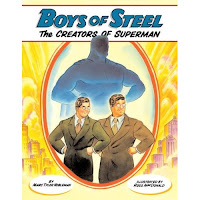 But here’s a terrific picture book biography, as tenuous as its connection to July 4th might seem-- Boys of Steel: The Creators of Superman. Possibly the most famous American cultural icon ever, Superman was born during a tough time in this country’s history. Seventy years ago, in 1938, you were either still suffering from the Great Depression or worried sick about the upcoming world war. To the rescue came two super-nerdy teens from Cleveland (who many a sensitive kid will identify with). They responded to trauma by inventing the world’s first superhero. Jerry Siegel and Joe Schuster persisted through years of rejection and later bad treatment from their publishers, searching for truth and justice as they created comic books that boosted American morale. Marc Tyler Nobleman tells his story swiftly, focusing on key dramatic moments, with a detailed afterword showing his intensive research. The stylish illustrations, in an appropriately retro palette, are by Ross Macdonald (Knopf, ages 7-10).
But here’s a terrific picture book biography, as tenuous as its connection to July 4th might seem-- Boys of Steel: The Creators of Superman. Possibly the most famous American cultural icon ever, Superman was born during a tough time in this country’s history. Seventy years ago, in 1938, you were either still suffering from the Great Depression or worried sick about the upcoming world war. To the rescue came two super-nerdy teens from Cleveland (who many a sensitive kid will identify with). They responded to trauma by inventing the world’s first superhero. Jerry Siegel and Joe Schuster persisted through years of rejection and later bad treatment from their publishers, searching for truth and justice as they created comic books that boosted American morale. Marc Tyler Nobleman tells his story swiftly, focusing on key dramatic moments, with a detailed afterword showing his intensive research. The stylish illustrations, in an appropriately retro palette, are by Ross Macdonald (Knopf, ages 7-10).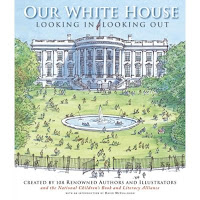 And in the realm of self-promotion, I have a one-page piece in the upcoming Our White House: Looking In, Looking Out. It keeps company with 107 other contributors-- authors (from Katherine Paterson to Kate DiCamillo to Jon Scieszka), illustrators (from Leo and Diane Dillon to Peter Sis to Brian Selznick), and famous folks (from Charles Dickens and Walt Whitman to Richard Nixon and Dick Cheney). At 242 well-designed pages, this anthology is the mother of all tributes to American history, a multi-faceted jewel for family sharing and endless uses in the classroom (to be developed on its companion website ). A few poems and short stories and plays sprinkle the mix, but mostly this is a nonfiction account of history as it affected our White House—the emphasis on our—and a call to learn more about being an American citizen (Candlewick, ages 8 and up).
And in the realm of self-promotion, I have a one-page piece in the upcoming Our White House: Looking In, Looking Out. It keeps company with 107 other contributors-- authors (from Katherine Paterson to Kate DiCamillo to Jon Scieszka), illustrators (from Leo and Diane Dillon to Peter Sis to Brian Selznick), and famous folks (from Charles Dickens and Walt Whitman to Richard Nixon and Dick Cheney). At 242 well-designed pages, this anthology is the mother of all tributes to American history, a multi-faceted jewel for family sharing and endless uses in the classroom (to be developed on its companion website ). A few poems and short stories and plays sprinkle the mix, but mostly this is a nonfiction account of history as it affected our White House—the emphasis on our—and a call to learn more about being an American citizen (Candlewick, ages 8 and up). Blog: I.N.K.: Interesting Non fiction for Kids (Login to Add to MyJacketFlap)
JacketFlap tags: 2008 titles, Kathleen Krull, book reviews, Add a tag
Sorry, I must gush about our first Fartiste signing, a giddy event at IRA in Atlanta where Paul and I signed books as fast as we could. (I would describe the sensation as like being on drugs, but you would think I’m obsessed.) I had talked up the book at the two sessions I spoke at, but most people in line had simply seen the title in the IRA program and had to have it. Yep-- all the laughing teachers and librarians were buying the book for males, a significant percent for their reluctant readers, and another major percent as gifts for husbands... fathers...even grandpas. Paul and I got even fizzier when we learned on site of our first review-- a star from Kirkus in its kindest mode: “Put that tired copy of Walter the Farting Dog away: This long-overdue tribute to Le Petomane, ‘the man who made his pants dance,’ is a total blast.”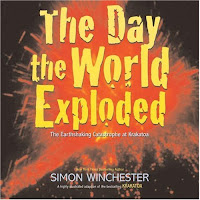 OK, on to hot-off-the-press books by other people, such as The Day the World Exploded. What kid could resist such a title? The subtitle explains all-- The Earthshaking Catastrophe at Krakatoa. It was the most violent explosion ever recorded, destroying the Indonesian island of Krakatoa in 1883. Followed by a tsunami that killed at least 36,00, it became known as the "mother" of all natural disasters. The explosion caused 13 percent of the earth's surface to vibrate, and it actually changed the way people thought about the world. Edvard Munch, to take but one example, was inspired to paint The Scream. This blend of history (of all sorts of things), science (of all kinds), and insights about the meaning of life goes down easy. In full color, it's even easy to visualize, with maps, diagrams, archival photos and etchings, plus dramatic new drawings by Jason Chin. Wherever possible, author Simon Winchester and his adapter Dwight Jon Zimmerman pull in info relevant to today; a second edition will probably mention that Krakatoa is not far from the ongoing disaster in Myanmar. A splendid example of this trend of downsizing popular adult books (in this case, Winchester's Krakatoa) into ones worthy of kids (HarperCollins, ages 10-14).
OK, on to hot-off-the-press books by other people, such as The Day the World Exploded. What kid could resist such a title? The subtitle explains all-- The Earthshaking Catastrophe at Krakatoa. It was the most violent explosion ever recorded, destroying the Indonesian island of Krakatoa in 1883. Followed by a tsunami that killed at least 36,00, it became known as the "mother" of all natural disasters. The explosion caused 13 percent of the earth's surface to vibrate, and it actually changed the way people thought about the world. Edvard Munch, to take but one example, was inspired to paint The Scream. This blend of history (of all sorts of things), science (of all kinds), and insights about the meaning of life goes down easy. In full color, it's even easy to visualize, with maps, diagrams, archival photos and etchings, plus dramatic new drawings by Jason Chin. Wherever possible, author Simon Winchester and his adapter Dwight Jon Zimmerman pull in info relevant to today; a second edition will probably mention that Krakatoa is not far from the ongoing disaster in Myanmar. A splendid example of this trend of downsizing popular adult books (in this case, Winchester's Krakatoa) into ones worthy of kids (HarperCollins, ages 10-14).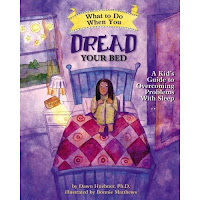 Am I the only one who’s a sucker for self-help books pitched at younger readers? When they’re done well, of course, as in the series of “What-to-Do Guides for Kids.” The newest, by child psychologist Dawn Huebner, is What to Do When You Dread Your Bed, a clever title subtitled A Kid's Guide to Overcoming Problems with Sleep. I would imagine that this 96-page paperback would be particularly handy for therapists and concerned parents (who are addressed in the introduction). But with its language, concepts, and art (cartoony illustrations by Bonnie Matthews) it's actually aimed straight at kids: "Wouldn't it be great if you could climb into bed, snuggle under your covers, close your eyes, and fall asleep without any fuss or fear?" And if you can't? You're not alone. Insomnia, nightmares, fear of the dark, crawling into bed with your parents-- such problems affect one of every three children, according to the author. So here is a workbook full of advice and practical techniques to improve sleeping skills-- an honest, head-on approach to one of life's frustrations (Magination Press/American Psychological Association, ages 9-12).
Am I the only one who’s a sucker for self-help books pitched at younger readers? When they’re done well, of course, as in the series of “What-to-Do Guides for Kids.” The newest, by child psychologist Dawn Huebner, is What to Do When You Dread Your Bed, a clever title subtitled A Kid's Guide to Overcoming Problems with Sleep. I would imagine that this 96-page paperback would be particularly handy for therapists and concerned parents (who are addressed in the introduction). But with its language, concepts, and art (cartoony illustrations by Bonnie Matthews) it's actually aimed straight at kids: "Wouldn't it be great if you could climb into bed, snuggle under your covers, close your eyes, and fall asleep without any fuss or fear?" And if you can't? You're not alone. Insomnia, nightmares, fear of the dark, crawling into bed with your parents-- such problems affect one of every three children, according to the author. So here is a workbook full of advice and practical techniques to improve sleeping skills-- an honest, head-on approach to one of life's frustrations (Magination Press/American Psychological Association, ages 9-12).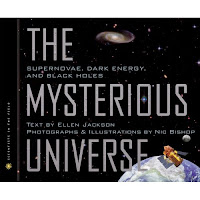
The Mysterious Universe-- yet another tempting title, and what a fascinating science book this is. Subtitled Supernovae, Dark Energy, and Black Holes, this is the newest in the well-received “Scientists in the Field” series. Focusing on the work of astronomy professor Alex Filippenko, who uses the most powerful telescopes ever, this enlightens us on discoveries that are being made right now about the big bang, our expanding universe, time travel, spiraling galaxies, dark matter, not to mention how exciting it can be to be a scientist. Ellen Jackson writes clear, high-interest text (though in some unfortunately tiny fonts, not her fault), with stark black backgrounds making NASA's and Nic Bishop's photos even more dramatic. Includes a thorough glossary for those of us not up on these ultra-mysterious matters (Houghton Mifflin, ages 9-12).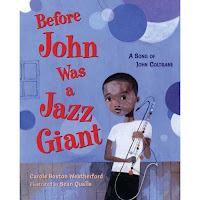 For the very young and the musically inclined (the same thing, really), Before John Was a Jazz Giant: A Song of John Coltrane makes a lovely, lyrical tribute. Coltrane wasn't born knowing how to create innovative jazz with his sax. His childhood was all about listening, lots of listening, to the sounds a child growing up in the South in the 1930s might have heard-- bones knocking around in a grandma's pot, the rhythms of a grandpa's sermons, birds singing, steam engines whistling, big bands on the radio. Carole Boston Weatherfor shapes the sounds into a flowing story, while Sean Qualls accompanies her with airy, mixed-media illustrations. A detailed Author's Note gives a full biography and a list of CDs to listen to.
For the very young and the musically inclined (the same thing, really), Before John Was a Jazz Giant: A Song of John Coltrane makes a lovely, lyrical tribute. Coltrane wasn't born knowing how to create innovative jazz with his sax. His childhood was all about listening, lots of listening, to the sounds a child growing up in the South in the 1930s might have heard-- bones knocking around in a grandma's pot, the rhythms of a grandpa's sermons, birds singing, steam engines whistling, big bands on the radio. Carole Boston Weatherfor shapes the sounds into a flowing story, while Sean Qualls accompanies her with airy, mixed-media illustrations. A detailed Author's Note gives a full biography and a list of CDs to listen to.
As for today’s outrageous title above and what on earth “sexy” could have to do with the world of children’s books, I refer you to The Craft & Business Of Writing: Essential Tools For Writing Success (Writers Digest Books). It's a brand-new tome that reprints an old article of mine with this question as its title and an elaborate case for an affirmative answer: After you swap out "sexy" for "stimulating," nonfiction clearly rules-- for readers and writers.
Blog: I.N.K.: Interesting Non fiction for Kids (Login to Add to MyJacketFlap)
JacketFlap tags: 2008 titles, Kathleen Krull, drugs, Add a tag
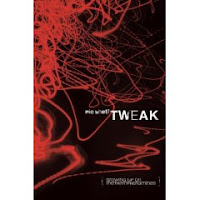 Quick, can you name a nonfiction book on the BookSense “Children’s Interest” bestseller list? Oddly enough, there have been several of them over the past few weeks, but the big sensation is a memoir called Tweak: Growing Up on Methamphetamines, a true story as lived and told by Nic Sheff. How low can he sink? Think as low as you can go. Not exactly the nicey-nice topics we usually blab about in our field, and this is definitely YA, not for children. Plus, in its explicit and accurate (I asked around) depiction of how crystal meth and heroin will wreck your life, this has flaws. Repetitious (way TMI), self-indulgent, writing that is raw and not "tight" (in either the literary or the kid-slang sense), and most of all a dearth of insight: despite the title, there's not much upward motion here. Some experts say that mental development ceases when a person becomes an addict, in which case Sheff-- who started at age 11-- may be stuck at an age earlier than his biological one (early twenties). Still, some kids will find this hard to put down—it’s, er, addictive—and if it leads any of them to think twice about making disastrous choices, the book is worthy of its bestsellerdom (Simon & Schuster, 2008, definitely ages 12 and up.)
Quick, can you name a nonfiction book on the BookSense “Children’s Interest” bestseller list? Oddly enough, there have been several of them over the past few weeks, but the big sensation is a memoir called Tweak: Growing Up on Methamphetamines, a true story as lived and told by Nic Sheff. How low can he sink? Think as low as you can go. Not exactly the nicey-nice topics we usually blab about in our field, and this is definitely YA, not for children. Plus, in its explicit and accurate (I asked around) depiction of how crystal meth and heroin will wreck your life, this has flaws. Repetitious (way TMI), self-indulgent, writing that is raw and not "tight" (in either the literary or the kid-slang sense), and most of all a dearth of insight: despite the title, there's not much upward motion here. Some experts say that mental development ceases when a person becomes an addict, in which case Sheff-- who started at age 11-- may be stuck at an age earlier than his biological one (early twenties). Still, some kids will find this hard to put down—it’s, er, addictive—and if it leads any of them to think twice about making disastrous choices, the book is worthy of its bestsellerdom (Simon & Schuster, 2008, definitely ages 12 and up.)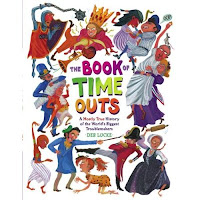 For bad choices considerably easier to talk about, The Book of Time Outs is a diabolically clever concept book. Author/artist Deb Lucke suavely subtitles it A Mostly True History of the World's Biggest Troublemakers. Wry text and expressive portraits feature those who were greedy (Napoleon), untruthful (Columbus), unwashed (Queen Isabella), awful to their siblings (Cleopatra), and ten more guys and gals with flaws. A unique way of looking at world history, an empathetic gift for a child who's just misbehaved (with messages like "you're not the first to have a time out," "you're not the worst," and "actions have consequences"), and irresistible to just about anyone (Simon & Schuster, 2008, ages 4-8).
For bad choices considerably easier to talk about, The Book of Time Outs is a diabolically clever concept book. Author/artist Deb Lucke suavely subtitles it A Mostly True History of the World's Biggest Troublemakers. Wry text and expressive portraits feature those who were greedy (Napoleon), untruthful (Columbus), unwashed (Queen Isabella), awful to their siblings (Cleopatra), and ten more guys and gals with flaws. A unique way of looking at world history, an empathetic gift for a child who's just misbehaved (with messages like "you're not the first to have a time out," "you're not the worst," and "actions have consequences"), and irresistible to just about anyone (Simon & Schuster, 2008, ages 4-8). Lots o’ green books sprouting all of a sudden. One of the most interesting is How We Know What We Know About Our Changing Climate. This is actually a children's version of a university-press tome by photojournalist Gary Braasch, Earth Under Fire: How Global Warming Is Changing the World. Now it has a text by Lynne Cherry (well-known for The Great Kapok Tree and other environmental books), and it's subtitled Scientists and Kids Explore Global Warming. What are butterflies, birds, flowers--not to mention a lot of super-smart people--trying to tell us? The world is starting to sizzle, and the clues are literally everywhere. In motivating readers (especially budding scientists) to save the planet, Cherry goes into substantial detail on the latest data, how researchers work, and what kids can do, with an unusually thorough section on further resources. Braasch contributes his stunning photos, wisely including kids in scenes as often as possible. Worthy of bestsellerdom, the ultimate in the recent trend of taking adult projects and distilling them for younger readers (Dawn Publications, 2008, ages 10-14).
Lots o’ green books sprouting all of a sudden. One of the most interesting is How We Know What We Know About Our Changing Climate. This is actually a children's version of a university-press tome by photojournalist Gary Braasch, Earth Under Fire: How Global Warming Is Changing the World. Now it has a text by Lynne Cherry (well-known for The Great Kapok Tree and other environmental books), and it's subtitled Scientists and Kids Explore Global Warming. What are butterflies, birds, flowers--not to mention a lot of super-smart people--trying to tell us? The world is starting to sizzle, and the clues are literally everywhere. In motivating readers (especially budding scientists) to save the planet, Cherry goes into substantial detail on the latest data, how researchers work, and what kids can do, with an unusually thorough section on further resources. Braasch contributes his stunning photos, wisely including kids in scenes as often as possible. Worthy of bestsellerdom, the ultimate in the recent trend of taking adult projects and distilling them for younger readers (Dawn Publications, 2008, ages 10-14).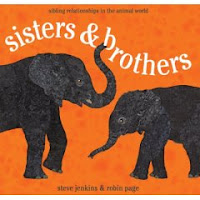 You don’t even have to like animals to find Sisters & Brothers: Sibling Relationships in the Animal World a treat. Heck, you don't have to be a kid. This is one juicy topic. I mean, painless intro to zoology. Which creatures have stepsiblings? (Catfish.) Which ones have only sisters? (New Mexico whiptail lizards.) Which ones eat each other? (Black widow spiders.) Which brothers' fights escalate so terribly that one them simply has to leave? (Grizzly bears.) Sorry, it's hard to stop with the examples, and all of them are well-grounded here in simple scientific language, with pages of animal facts at the end. Score a winner for Robin Page and I.N.K.’s own Steve Jenkins, with his distinctive cut-paper collages, amusingly captioned, set against oceans of white space (Houghton Mifflin, 2008, ages 4-8).
You don’t even have to like animals to find Sisters & Brothers: Sibling Relationships in the Animal World a treat. Heck, you don't have to be a kid. This is one juicy topic. I mean, painless intro to zoology. Which creatures have stepsiblings? (Catfish.) Which ones have only sisters? (New Mexico whiptail lizards.) Which ones eat each other? (Black widow spiders.) Which brothers' fights escalate so terribly that one them simply has to leave? (Grizzly bears.) Sorry, it's hard to stop with the examples, and all of them are well-grounded here in simple scientific language, with pages of animal facts at the end. Score a winner for Robin Page and I.N.K.’s own Steve Jenkins, with his distinctive cut-paper collages, amusingly captioned, set against oceans of white space (Houghton Mifflin, 2008, ages 4-8).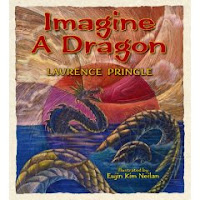 You might think Imagine a Dragon would be collection of fluffy poems going nowhere special, but you’d be wrong. Instead, esteemed science writer Laurence Pringle has compiled a treasury of true stuff about this beast, illustrious but wholly imaginary. Starting with the earliest rumors in China, Egypt, and present-day Iraq, a dragon worked nicely as an explanation for natural disasters, scientific phenomena, anything that seemed scary. Pringle zooms around the globe to glean the primo dragon facts and legends, while lush paintings in acrylic by Eujin Kim Neilan make the pages swirl. Good example of a handsome nonfiction picture book, and an appealing choice for kids shifting out of fairy tales (Boyds Mills, 2008, ages 7-9).
You might think Imagine a Dragon would be collection of fluffy poems going nowhere special, but you’d be wrong. Instead, esteemed science writer Laurence Pringle has compiled a treasury of true stuff about this beast, illustrious but wholly imaginary. Starting with the earliest rumors in China, Egypt, and present-day Iraq, a dragon worked nicely as an explanation for natural disasters, scientific phenomena, anything that seemed scary. Pringle zooms around the globe to glean the primo dragon facts and legends, while lush paintings in acrylic by Eujin Kim Neilan make the pages swirl. Good example of a handsome nonfiction picture book, and an appealing choice for kids shifting out of fairy tales (Boyds Mills, 2008, ages 7-9).No Fartistic news this time… come back next month. Meanwhile, hope to see you at TLA or IRA.
Blog: I.N.K.: Interesting Non fiction for Kids (Login to Add to MyJacketFlap)
JacketFlap tags: 2008 titles, math literature, Loreen Leedy, Add a tag
My book for Spring of 2008 has a simple premise—how life would change if math and numbers were suddenly gone. What if you couldn't count, or add, or measure, or tell time…? Here’s a preview of Missing Math: A Number Mystery.
We usually see books only when they're in their pristine final form, printed in living color on coated paper (in the case of picture books, anyway.) This post will give a sense of the behind-the scenes gyrations, which took longer than usual in this case.
Version #1: The Number Cruncher was a picture book written in verse. I still like the play on words of the title. The main character ran around eating any number he saw. Some sort of monster or alien, here’s what he looked like:
The dummy is undated and my memory inexact, but it’s before I went digital for illustration around 1997 so it’s over ten years old. There are some handwritten notes, such as maybe he should be more of a robot-like character. I didn't realize it until now, but the 25 m.p.h. speed limit sign somehow endured through all the versions to appear in Missing Math. Although the specific reason this version was rejected has faded, in retrospect, consuming a few numbers here and there doesn't have enough impact.
Version #2: No More Math? Still a picture book, it had become an updated three wishes story in prose about a boy who encounters a robot alien who has crash-landed. It starts out:
A robot alien! And a spaceship! The whole scene was a shocker, but I had my sneakers on in case I had to make a quick getaway. There was nothing to worry about, because this guy could barely find the tool box, not to mention a ray gun.
In return for his help, the robot offers to grant the boy three wishes, and the plot lumbers on. In rereading this, it’s so long-winded I can see why my editor suggested I try…
Version #3: The Day Math Disappeared, a chapter book version. The manuscript is dated 2001:
…Don’t ask me where he came from, I didn’t find out. It is a good question, though. Some secret government project? Anyway, once he decided I wasn’t going to dismantle him or anything, he went back to working on the ship or plane, or whatever. He called it his “ziptek,” so we can just stick with that.
My nephew Caleb read it and liked it, even if my editor ended up giving the thumbs down on it. The concept was probably too young for a chapter book.
Version #4: When Math Took a Vacation is a picture book again, with a main character named “Math.” He supervises the numbers who cheerfully perform their jobs on rulers, mailboxes, license plates, and so on. That is, until Math takes a well-deserved vacation—while the boss is away, the numbers play and havoc ensues. Another rejection, which wasn’t too surprising at this point. Here are some of the number characters at work before they run off to sip sodas at the seashore, or whatever they were doing:
Version #5: The Number Cruncher, is dated 2005 and told in first person from the viewpoint of a little boy:
Somebody ATE my money last night!
And Something bit my shirt,
my notebook got nibbled,
my homework has holes,
and my books are dripping with drool… YUCK!
Something totally WEIRD is going on.
It’s in sort of a non-rhyming poetic format, which may be why my editor suggested I try it in rhyming verse. Verse? I hadn’t written anything in rhyme since 1990. Sure, why not? That ended up being the manuscript for Missing Math. It has an all-animal cast, some nonsensical angles such as not even being able to THINK of a number, and a weird machine that is being used to steal the numbers for some unknown purpose. Fortunately, there is a persistent cat detective who is determined to solve the mystery of the missing math. You can see him on my site.
So why did I persevere in the effort to get this notion into book form? Despite the setbacks, I stayed in love with the the idea of making math vanish as a way to help kids perceive how integral it is to everyday life. But credit must also go to my editor Margery Cuyler who never forgot about it for all those years, and kept asking to see the “no math” idea in some new form. Her interest motivated me to rethink it. Missing Math: A Number Mystery gets right to the point and shows how completely things fall apart. But, it would’ve been nice if it had come together just a tad more quickly!
If anyone would like more info about how I made the video preview for Missing Math, please check out The Dust of Everyday Life blog, which gives an overview of the software used. The post is titled Making a Book Preview (Trailer). Other people there have also written about making book trailers.
Blog: I.N.K.: Interesting Non fiction for Kids (Login to Add to MyJacketFlap)
JacketFlap tags: 2008 titles, Kathleen Krull, edginess, golden age, 2008 titles, edginess, golden age, Add a tag
Fascinating information, distilled into age-appropriate language, fully synthesized by a warm and witty authorial presence, narrated in a compelling voice… illustrated/visualized with flair… labored over by smart editors, copyeditors, fact-checkers, and designers….
Can a children’s nonfiction book be a work of art, a hallmark of civilization, a gem among gems, a---- OK, OK, I’m biased. But is it possible that we live in a golden age for children’s nonfiction books? Or have I gone over the edge?
Let’s consider some juicy titles so far in 2008.
Newcomer (to children’s books) Philip Dray tackles the harrowing subject of lynching in Yours for Justice, Ida B. Wells: The Daring Life of a Crusading Journalist. The executions of black citizens, completely outside the law, began almost as soon as the Emancipation Proclamation was signed, reached a peak of one almost every other day, and didn’t end until the 1950s. Sensibly, Dray clothes his topic within a biography of one courageous person, Ida B. Wells. She was born a slave in 1862, started teaching school at 16, and became a noted journalist. Publishing articles, giving speeches, often at great personal risk, she used her fame to shed light on the horrors of lynching, becoming the most effective crusader against it. The reader comes to know Wells in full detail, with six pages of solid information in the back matter for extra value. Stephen Alcorn’s stylized watercolors swirl with Wells’s energy and anger—just look at the cover with page after page radiating from her rising figure. Recent events in the news make this book a must-have for schools (Peachtree Publishers, 2008, ages 10-14).
Former mighty librarian Julie Cummins flexes her mighty research muscles in Women Daredevils: Thrills, Chills, and Frills. Male daredevils are all over the place, ho hum. But have you ever heard of May Wirth (billed as the Greatest Bareback Rider Who Ever Lived), Zazel (known as the Human Cannonball), Annie Edson Taylor (first person to go over Niagara Falls in a barrel), or Mabel Stark (“the world’s greatest tiger tamer and trainer”)? I haven’t, nor of any of the fourteen action-loving performers in this book. Their feats were all the more astonishing for taking place between 1880 to 1929, an era when women were supposed to sit still and not engage in sports, much less extreme ones. Cummins delves into her daredevils’ exploits, their motives, what they did in their off hours, and what else is known about their lives. A great gift for athletic kids, and a real contribution to women’s history, with Cheryl Harness’s illustrations leaping ecstatically off the page (Dutton, 2008, ages 8-12).
Befitting its rowdy subject, both text and art simply sizzle in What to Do About Alice: How Alice Roosevelt Broke the Rules, Charmed the World, and Drove Her Father Teddy Crazy!. Teddy would be Theodore, who famously moaned, “I can be president of the United States, or I can control Alice. I cannot possibly do both.” Alice liked to call her rambunctious style of living “eating up the world,” and it frequently got her in trouble at a time when proper young ladies had tiny appetites. Besides learning about one unusual woman, history-lovers will appreciate that the reader learns a lot about the President, his election to office in 1901 after Alice turned 17, and how and why she boosted his popularity. Barbara Kerley’s spirited storytelling skills are matched with newcomer Edwin Fotheringham’s ingenious depictions of one of the biggest celebrities of her day. Though we believed her dead since 1980, Alice strikes again! (Scholastic, 2008, ages 4-8).
You want more recommendations? I got plenty. What hot books have YOU noticed so far this year?
Finally—and for a book not about a woman and really silly—coming your way is my next book, called Fartiste. 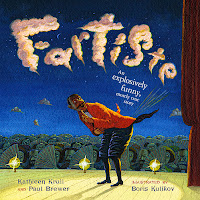
It’s a biography of a unique performance artist who had audiences literally fainting with laughter at Paris’s Moulin Rouge in the late 1800s. Joseph Pujol perfected “the art of the fart” by training his, er, muscles to mimic sound effects, tunes, stories. No, I’m not kidding, and yes, it’s all true. If you think this is gross, blame my husband, illustrator Paul Brewer, collector of extremes of information, amidst which he discovered Pujol, little-known now but in his day the most famous performer in the world. We co-wrote the story in verse, passing the manuscript back and forth to tweak the humor to its max. It’s being published by the brave souls at Simon & Schuster this June, with illustrations by Boris Kulikov that somehow quadruple the fun.
We think the book will have kids rolling on the floor. But what will the grown-ups say—the reviewers, teachers, librarians? Paul and I are on pins and needles (not the best image to associate with our promo item--whoopee cushions). Have we seriously gone over the edge?
Note: The links are to oh-so-convenient Amazon, but for actual purchases your local independent bookstore is the best friend a children’s nonfiction writer could have. I apologize for the lack of graphics, but just getting the links to Amazon in here nearly killed me.
Blog: So many books, so little time (Login to Add to MyJacketFlap)
JacketFlap tags: out of the mouths, Add a tag
There is nothing like going to the source, or as close as you can get it, for jargon. I was telling another doctor how much I liked my surgeon. He had a good bedside manner in the office, but once he was in scrubs he radiated happiness. He clearly loved to do surgery. And this other doc said, "I've only scrubbed in with him four or five times, but I love to watch him operate." "Scrubbed in"! What perfect doctorly jargon.
Or I'm reading a book from a guy who joined the FBI and had to endure being the FNG for the first year, or Fucking New Guy. Again, interesting jargon. Don't make it up. Don't count on what you hear on TV being right. Go to the source if you can.
I've heard that Mario Puzo made up most of the mob slang he used – and that later the real mob picked it up. Life imitating art.
Subscribe with
JacketFlap's
Children's
Publishing
Blog Reader



I am sad that I woke up this morning with the sun and it was 7:30. I don't want to have to set an alarm!
Can't wait to meet you, Susan! Correction on the date: March 15, the Ides of March.. tomorrow... is our panel.
Oy, thanks for the proofreading Deb, it's fixed. See you tomorrow.
15-year-old son got up today grumbling (well, he grumbles every day when he gets up but today was a record breaker). I can't wait to tell him he owes DST and the evil sun in his eyes to a golfer! Watch out Tiger!
As for worrying over what to include or not include in a book, my answer is that it's a constant issue with me. When I did Inside the Alamo one bit of research suggested that Davy Crockett may have escaped the Alamo dressed as a woman. My original editor on the project and I spent a lot of time chuckling over including a Crockett cross-dressing chapter to see if anyone would notice. Of course, we never did, but I have a feeling some folk these days would just to get attention.
Have fun in Boston.
Susan, I didn't catch the mistake. Someone else did. I am a lousy proofreader! Can't wait to see you tonight. And Jim, I just finished reading the latest Horn Book issue. I love your quotes in Sue Bartoletti's article. "Lunatic overdrive gear. "